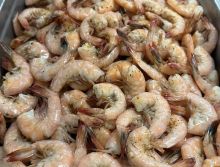
You might associate fresh-caught shrimp with summertime, but the best shrimp of the year – the greentails – are being harvested right now. If you want to eat the best fresh-caught shrimp of your life, now is the time to do it. Any local restaurant that is serving just-caught local greentails should be proudly announcing this fact to you. Be sure to try them!
What we call greentails on the Outer Banks are actually white shrimp. They are caught in the sound in the early fall and in the ocean in the late fall and winter months, as opposed to brown shrimp, which are caught in the sound in the summer and early fall months. Both species of shrimp are delicious, but these winter greentails are sweeter, lighter and tastier, with a firm flesh and delicate buttery flavor. I don’t use the word succulent often, but this it’s the perfect word to describe greentail shrimp.
It’s hard to believe that up until the 1900s, shrimp were considered pests. Commercial fishermen called them bugs and threw them out of the nets to save for farmers to use as fertilizer (shrimp heads and shells do make great compost and fertilizer). When people did start eating shrimp — and after ice became available for storage and the trawler was introduced in the 1930s — North Carolina’s shrimping industry took off. Shrimping is North Carolina’s second-largest seafood industry after blue crabs.

This photo and below: Harvesting greentail shrimp on the Silver Dollar.
I hope everyone who lives on or visits the Outer Banks realizes how lucky we are to have the availability of fresh, wild-caught shrimp. Shrimp is a very popular food, but the shrimp that most of the world eats is not wild or fresh. Most of the shrimp the world eats is farm-raised in Asia, frozen then shipped around the world. These shrimp are loaded with preservatives and chemicals. Wild-caught, just-off-the-boat Carolina shrimp is a delicacy that most people in the world will never experience. They taste way better and are way more nutritious and they are caught sustainably.
Here in the Carolinas, shrimp are harvested sustainably using specialized gear that reduces the impact on other sea life. Look out in the ocean this time of year or the sound in the summer and you can see the smaller shrimp trawlers with their long arms surrounded by hundreds of hovering seagulls. These boats are being operated by local captains and local crew – people who live on the Outer Banks and contribute to our economy. Their harvest supports not only their own families, but also the seafood market purveyors, processors, retailers, restaurants and their employees, and all the various people who are involved with getting those boats on the water and the seafood to your plate.

Frozen, wild-caught, local shrimp is always, always better than farm-raised. Every time. Local shrimp tastes better, of course, but it’s also an issue of taking care of the local shrimp industry. Farm-raised shrimp are cheap and abundant and they are flooding the market. There is a real danger that these cheap shrimp will put North Carolina shrimpers out of business.
If you must eat farm-raised shrimp (the stuff you’ll see bagged in the grocery freezer section), for health reasons make sure it was farm-raised in the United States, which regulates the process and the product. You never know what you’re getting when you eat foreign farm-raised shrimp. Better yet, with a little effort, you’ll never have to eat farm-raised shrimp again!
How to Stock Up on Local Shrimp
Shrimp freeze beautifully. Many chefs and seafood markets buy their greentail shrimp now and freeze them to serve or sell later in the year. This is totally fine because shrimp can be frozen for up to a year and still taste the same. So if you see local greentail shrimp being sold in a market or served on a menu in the spring, summer or early fall, it’s perfectly OK to eat them. They will taste just as good as fresh.
You can freeze shrimp too. Some people freeze their shrimp in water, but Lara O’Neal, seafood purveyor at O’Neal’s Seafood in Wanchese, says O’Neal’s just bags theirs and pops them in the freezer, no water needed. “They come out fine, just as good,” she says. “The greentail shrimp do freeze better than the brown shrimp. Both are good frozen, but the brown shrimp tend to change color while the greentails stay the same color. They both still taste great.”

Photo: A cooler full of fresh, heads-on shrimp iced up at Outland Seafood in Manns Harbor.
This is a big year for winter greentail shrimp (rising water temperatures are thought to contribute to their abundance here at their northern range) so the prices are low and it’s a great time to stock up your personal freezer. If you have the space for 10, 20 or 30 pounds of shrimp in your freezer and a few hours to de-head shrimp, you can enjoy Carolina greentails all year long. For a little more money you can buy frozen shrimp in bulk to stock your freezer.
At local markets you can buy shrimp frozen with heads on, frozen with heads off or stock up on pounds of fresh shrimp to freeze.
It’s not hard to head shrimp. Simply pinch off the heads, put the shrimp in a freezer bag and freeze them. Lay the bags perfectly flat in your freezer so they take up less space. When you’re ready to eat them, defrost a bag of shrimp, peel and devein them and eat them up.
If you want to buy bulk shrimp, fresh or already frozen, call ahead to your local fish market or fish house. A lot of these local shrimp get shipped off, so if you want a bulk order they can save some for you. See a list of local seafood markets and fish houses here.


 Molly Harrison is managing editor at OneBoat, publisher of OuterBanksThisWeek.com. She moved to Nags Head in 1994 and since then has made her living writing articles and creating publications about the people, places and culture of the Outer Banks.
Molly Harrison is managing editor at OneBoat, publisher of OuterBanksThisWeek.com. She moved to Nags Head in 1994 and since then has made her living writing articles and creating publications about the people, places and culture of the Outer Banks.

